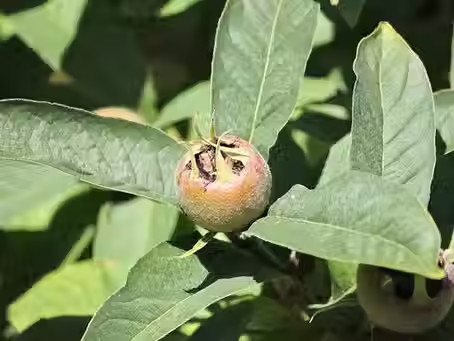top of page

pendragon orchard and vine
Turning Landscape into Legacy
Blog
Subscribe for writing that turns landscapes into legacies
Search


Sweet After the Freeze: Remembering Growing, and Eating the Medlar
Long after apples are gone and pears are stored away, the medlar still hangs—brown, frost-touched, and waiting. It’s a fruit that sweetens only after the cold, a reminder that not everything worth tasting comes in season.
Wolfy
Oct 134 min read


Designing Fragrant Gardens for the Pacific Northwest
For millennia, fragrance guided the design of gardens — from Persian courtyards to monastic cloisters. Today it’s often missing. In the Pacific Northwest, restoring scent means designing with intimacy, ecology, and time.
Wolfy
Oct 74 min read


Growing Wine Grapes in Seattle? Part 2: Variety and Rootstock
Growing grapes west of the Cascades isn’t about chasing the biggest names—it’s about matching what you plant to the heat, soil, and season you actually have. Varieties that ripen in 1400–2300 GDD and rootstocks that can handle pests, low pH, and wet soils are the difference between fruit worth crushing and years of disappointment. Like raising kids, success comes from giving them the right foundation and the right place to grow.
Wolfy
Sep 278 min read


Edible Landscape Design with Pacific Northwest Natives: Hawthorn — Top 10 Permaculture Species
The Native Workhorse Hiding in Plain Sight Across the Pacific Northwest is, Arguably, the Ultimate Species for Edible Landscapes.
Wolfy
Sep 195 min read


Growing Olives in the Pacific Northwest: History, Survival, Struggle, and the Long Bet.
Every olive carries history in its roots — Athens crowned with Athena’s gift, Noah reading the branch as landfall, empires rising and falling while the trees still bore fruit. To plant one here is to graft that long memory into Northwest soil, a wager that what endured for millennia might endure again.
Wolfy
Sep 178 min read


Growing Wine Grapes in Seattle? Part I: Climate and Site Selection
You can grow wine grapes in Western Washington—if you pick the right varieties and stay ahead of powdery mildew. Forget the mystique; with soil, sun, water, and patience, a backyard vineyard is within reach.
Wolfy
Sep 107 min read


Growing Figs in the Pacific Northwest: A Practical Guide for Growers
Figs aren’t just for the Mediterranean. In the Pacific Northwest, a handful of hardy cultivars thrive with the right microclimate and pruning. Learn which varieties deliver, how to favor breba crops over late-ripening duds, and why now is the best time to experiment with figs in Cascadia.
Wolfy
Sep 85 min read


Edible Landscape Design: A Chestnut is True Generational Wealth — Top 10 Permaculture Species
Chestnuts aren’t just nut trees — they’re living inheritance. From ancient groves in Italy still feeding families after 500 years to young orchards rising in the Northwest, these trees promise shade, food, and continuity long after we’re gone. Plant a pair today and you’re building more than a food forest — you’re building generational wealth.
Wolfy
Sep 43 min read


Edible Landscape Design: Aronia (Chokeberry) — Top 10 Permaculture Species
Why Aronia (Chokeberry) Is the Shrub That Crushes Blueberries in Nutrition, Resilience, and Design
Tamayo
Sep 34 min read


Edible Landscape Design: Russian Comfrey — Top 10 Permaculture Species
Russian comfrey isn’t a crop you grow and forget — it’s a permanent fixture in the food forest. The sterile Bocking 14 hybrid won’t spread by seed, but once rooted it becomes a long-term nutrient engine, pulling minerals from deep in the soil and cycling them into leaves you can cut again and again. We plant it around fruit trees not only for its mulch and pollinator blooms, but also as a living barrier that keeps out runner grasses.
Wolfy
Sep 13 min read


Edible Landscape Design: Jerusalem Artichoke (Sunchoke) — Top 10 Permaculture Species
A dense patch of Jerusalem artichokes with tall green stalks and bright yellow sunflower-like blooms, growing along a hillside with trees in the background.
Wolfy
Aug 293 min read


Sod Off: How Big Lawn Is Killing Us (and What to Plant to Mitigate Climate Change)
America’s biggest crop isn’t corn or wheat. It’s grass — and it’s complicit in cooking the planet. Here’s how we fix it without killing the lawn.
Wolfy
Aug 234 min read


Edible Landscape Design: Hazelnut (Filbert) — Top 10 Permaculture Species
Hazelnut (filbert) is a top permaculture design species: storable calories, oil, mulch, fencing, habitat, and a living screen—all from one resilient shrub.
Wolfy
Aug 183 min read


Seriously. Stop Hard Pruning Your Fruit Trees in Winter
Pruning is not conquest. It’s a negotiation with biology. It should be a conversation across seasons. And the blade should be an instrument of guidance — never of amputation . Every winter the cycle repeats: trees pruned down to stubs, their silhouettes reduced to skeletons against the sky. Owners look on, wincing but resigned, convinced this is what stewardship demands. They’ve been told it’s gospel. They’ve been sold on myth. But in summer the truth appears. Instead of fru
Wolfy
Aug 174 min read


Subscribe to Discover the Top 10 "Permaculture" Species: A Must-Read Series for all Gardeners.
Are you ready to delve into the fascinating world of permaculture and explore the top 10 species that can transform your sustainable gardening and farming practices? We're excited to announce that Pendragon Permaculture is embarking on an insightful journey, publishing a curated list of the most impactful permaculture species that every nature enthusiast, gardener, and eco-conscious individual should know about. Starting this month, we'll be unveiling a series of articles tha
Wolfy
Aug 16, 20231 min read


Small Space? Design Smart and Taste the Pacific Northwest’s Fruit Abundance
Since the first monastery gardens of Europe, growers have wrestled with the same quiet dilemma—how to fit Eden into a courtyard. The problem is not new. Every walled garden, every cloister orchard, was a study in constraint: soil, sun, and stone dictating what could live together and what must be left out. Space has always been the gardener’s first teacher.
Wolfy
Feb 21, 20203 min read


Permaculture's A-List Species: Helianthus maximiliani, A Perennial Sunflower
In permaculture, all things should have multi-functions. Topping my list this year is a lesser known sunflower that is perennial, edible, pollinator-friendly, drought tolerant, and just beautiful. It's Helianthus maximiliani, Maximilian Sunflower. I use this species on every project, as does our charity All Hands on Earth . Seeding is easy: sprinkle on the soil and press down lightly; water regularly until the shoots, which are edible, reach about 6-8" in height. Then let it
Wolfy
Jul 19, 20191 min read


Permaculture Gardening and Landscaping: Yamaimo (Dioscorea japonica)
Today we installed Yamaimo (Japanese Mountain Yam) as part of a permaculture food forest and gardening project on Orcas Island. Yamaimo often makes the species list for our projects by providing a high calorie, delicious, and reliable food source. Here below we are growing Yamaimo in pots filled mostly with sand and a little dirt taken from nearby plantings. Growing in pots makes harvesting the tubers easier: you dump the pot over when you are ready to harvest and they spill
Wolfy
Jun 26, 20191 min read


Permaculture Gardening and Landscaping: Square Orchard to Food Forest
Conversion of an established Square pattern orchard to a food forest on Orcas Island. Principal goals for the project: Improve Species (Food) Diversity; Convert Annuals to Perennials; Use Guilds and Super Guilds; Lower Long Term Maintenance Cost; Four Season Food Production; Restore/Add Privacy Screens; Create Social/Gathering Area; Improve Soil Structure; Add Color in the Winter; Native Habitat Restoration. Species List
Wolfy
Apr 19, 20191 min read
bottom of page